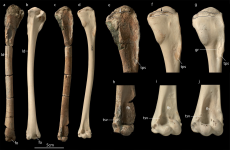Fred Ruhe
Well-known member

Daniel T. Ksepka & Alan J. D. Tennyson, 2023
Oldest fossil record of Sulidae from New Zealand
Journal of Ornithology
doi:10.1007/s10336-023-02117-0.
Abstract: Oldest fossil record of Sulidae from New Zealand - Journal of Ornithology
We report the oldest fossil record of Sulidae from New Zealand. Osteological features indicate that a humerus collected from the Hurupi Formation at Whatarangi Bluff (Wairarapa, North Island) belongs to a species more closely related to Morus (gannets) than to Papasula (Abbott’s Booby) or Sula (other boobies). The length of the humerus exceeds the species averages of all extant gannet species, and its age pre-dates the estimated divergence of extant Morus serrator. The Whatarangi fossil most likely represents an unnamed stem gannet species, and reveals that gannets dispersed to New Zealand at least twice.
Enjoy,
Fred
Oldest fossil record of Sulidae from New Zealand
Journal of Ornithology
doi:10.1007/s10336-023-02117-0.
Abstract: Oldest fossil record of Sulidae from New Zealand - Journal of Ornithology
We report the oldest fossil record of Sulidae from New Zealand. Osteological features indicate that a humerus collected from the Hurupi Formation at Whatarangi Bluff (Wairarapa, North Island) belongs to a species more closely related to Morus (gannets) than to Papasula (Abbott’s Booby) or Sula (other boobies). The length of the humerus exceeds the species averages of all extant gannet species, and its age pre-dates the estimated divergence of extant Morus serrator. The Whatarangi fossil most likely represents an unnamed stem gannet species, and reveals that gannets dispersed to New Zealand at least twice.
Enjoy,
Fred





